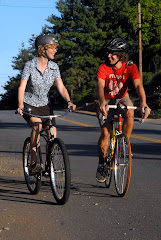
In their most recent email newsletter to members, the
League of American Bicyclists shared a new educational campaign aimed at fighting back against statements that discriminate against bicycles.a
On their web page,
Who’s Trash Talking Bikes?, the League has a list of recent anti-bike statements by politicians and pundits. For each one they include sections titled: “What he/she said”; “What’s the issue”; “What are the facts”; “What he/she could have said”; and “What you can do.”
Here’s how they deal with some recent trash talk from U.S. Senator Jim DeMint from South Carolina (I’ve included the links as they appear on the League’s site):
What he said:
“We must stop wasteful earmarks for bike paths and museums that divert critical funding away from priority roads and bridges,” DeMint said in a September 8 statement addressing a shortfall in highway funding.
U.S. Senator Jim DeMint,
trash talker.
What’s the issue:
The Highway Trust Fund, funded from gas taxes and “spent” by state Department’s of Transportation, is running out of money and needs an $8 billion infusion of cash, according to the US Department of Transportation. Senator DeMint is apparently blaming the shortfall on wasteful bike path projects.
What are the facts:
It’s true that the law approving the spending of the highway trust fund has a lot of Congressional earmarks for “high priority projects” – a total of $15 billion in the 2005 SAFETEA-LU legislation. However, bike paths account for less than five percent of those earmarks, and most of them haven’t even been started yet.
A much more immediate reason for the funding crisis is the dramatic fall in motor vehicle miles traveled (and thus gallons of gasoline bought) in recent months due to rising gas prices. Ironically, of course, bicycle use is soaring because of those same high gas prices, meaning that we actually need more bike facilities, not less.
In August 2007, after the Minneapolis bridge collapse, Secretary of Transportation Mary Peters made similarly unfortunate comments for which she has subsequently apologized. Bicycling and walking are critical components of our transportation system.
What he could have said:
We must stop wasteful earmarks and get transportation funding into the hands of local decision-makers to start solving some of our traffic, energy, environmental and health challenges by getting more people bicycling, walking and taking transit. We also need to change the funding process so that we reward ourselves for reducing the number of motor vehicle miles traveled.
What You Can Do
If you are from South Carolina, drop a line to your Senator and let him know that bicycling and bike paths are pretty important to you. Let him know that while earmarks are generally undesirable, the only reason most of the bike-related projects are even requested in the first place is because state Departments of Transportation still stubbornly refuse to implement them willingly.
If you aren’t from South Carolina, you can still drop him a note, or you can write your own members of Congress and let them know how much you disagree with Senator DeMint’s attack on bike paths – that way we might just discourage them from making this mistake in the first place.





















